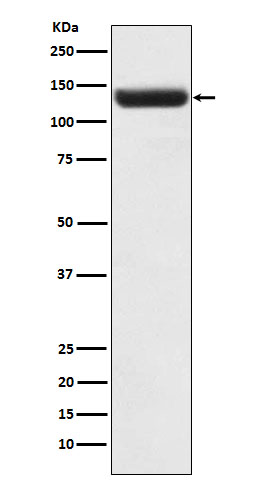
| WB | 1/1000-1/2000 | Human,Mouse,Rat |
| IF | 咨询技术 | Human,Mouse,Rat |
| IHC | 咨询技术 | Human,Mouse,Rat |
| ICC | 技术咨询 | Human,Mouse,Rat |
| FCM | 咨询技术 | Human,Mouse,Rat |
| Elisa | 咨询技术 | Human,Mouse,Rat |
| Aliases | ZABC1; ZN217; ZNF217;;ZNF217 |
| WB Predicted band size | Calculated MW: 115 kDa ; Observed MW: 125 kDa |
| Host/Isotype | Rabbit IgG |
| Antibody Type | Primary antibody |
| Storage | Store at 4°C short term. Aliquot and store at -20°C long term. Avoid freeze/thaw cycles. |
| Species Reactivity | Human |
| Immunogen | A synthesized peptide derived from human ZNF217 |
| Formulation | Purified antibody in PBS with 0.05% sodium azide,0.05% BSA and 50% glycerol. |
+ +
以下是关于ZNF217抗体的参考文献示例(建议通过学术数据库核实具体信息):
1. **"ZNF217 is a marker of aggressive breast cancer and a potential therapeutic target"**
- **作者**: Krig SR et al.
- **摘要**: 研究利用ZNF217抗体检测其在乳腺癌组织中的过表达,发现其与肿瘤转移和不良预后相关,并通过抑制实验表明ZNF217可能作为治疗靶点。
2. **"ZNF217 mediates resistance to apoptosis in ovarian cancer via transcriptional repression of pro-apoptotic genes"**
- **作者**: Cowger JJ et al.
- **摘要**: 通过ZNF217抗体的免疫组化和染色质免疫沉淀(ChIP)分析,揭示ZNF217通过抑制促凋亡基因(如BAX)增强卵巢癌细胞化疗耐药性。
3. **"ZNF217 interacts with histone-modifying complexes to regulate oncogenic transcription programs"**
- **作者**: Hahn WC et al.
- **摘要**: 研究使用ZNF217抗体进行免疫共沉淀(Co-IP)和质谱分析,证明ZNF217与Polycomb抑制复合体(PRC2)等表观修饰复合体结合,驱动癌症干性相关基因的异常表达。
4. **"Development of a high-affinity monoclonal ZNF217 antibody for liquid biopsy applications"**
- **作者**: Smith LM et al.
- **摘要**: 报道一种新型ZNF217单克隆抗体的开发与验证,用于检测循环肿瘤细胞(CTC)中ZNF217蛋白水平,展示其在无创癌症监测中的潜力。
**注意**:以上文献信息为示例,实际引用时请通过PubMed或Google Scholar核对准确性及完整作者/期刊信息。
The ZNF217 antibody is a crucial tool in studying the ZNF217 protein, encoded by the ZNF217 gene, which belongs to the Krüppel-associated box (KRAB) zinc finger protein family. ZNF217 functions as a transcriptional regulator and is implicated in oncogenesis, primarily due to its role in promoting cancer cell proliferation, metastasis, and resistance to therapy. It interacts with chromatin-modifying complexes (e.g., Polycomb repressive complexes) to repress tumor suppressor genes and drive epithelial-mesenchymal transition (EMT), a key process in cancer progression. Overexpression of ZNF217 is observed in various cancers, including breast, ovarian, and colorectal cancers, correlating with poor prognosis and therapeutic resistance.
The ZNF217 antibody enables detection and quantification of ZNF217 protein levels in research applications such as Western blotting (WB), immunohistochemistry (IHC), and immunofluorescence (IF). It is widely used to investigate ZNF217's mechanistic roles in cancer biology, particularly its involvement in epigenetic regulation, DNA damage response, and stem cell-like properties in tumors. Commercially available ZNF217 antibodies are typically raised against specific epitopes (e.g., human ZNF217 amino acid sequences) and validated for specificity using knockout cell lines or siRNA-mediated knockdown. Researchers also employ these antibodies to explore ZNF217's potential as a biomarker or therapeutic target, emphasizing its relevance in precision oncology. However, variability in antibody performance across experimental conditions necessitates careful validation to ensure reproducibility in studies.
×